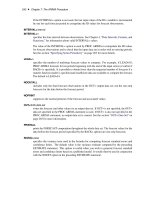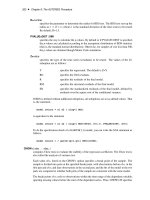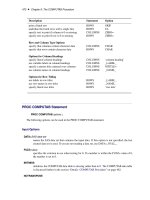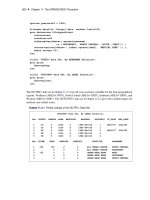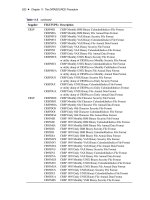SAS/ETS 9.22 User''''s Guide 2 doc
Bạn đang xem bản rút gọn của tài liệu. Xem và tải ngay bản đầy đủ của tài liệu tại đây (214.94 KB, 10 trang )
2
Chapter 1
What’s New in SAS/ETS 9.22
Contents
Overview . . . . . . . . . . . . . . . . . . . . . . . . . . . . . . . . . . . . . . . 3
Highlights of Enhancements . . . . . . . . . . . . . . . . . . . . . . . . . . 3
Highlights of Enhancements in SAS/ETS 9.2 . . . . . . . . . . . . . . . . . 4
AUTOREG Procedure . . . . . . . . . . . . . . . . . . . . . . . . . . . . . . . . 4
COUNTREG Procedure . . . . . . . . . . . . . . . . . . . . . . . . . . . . . . . 5
MDC Procedure . . . . . . . . . . . . . . . . . . . . . . . . . . . . . . . . . . . . 6
MODEL Procedure . . . . . . . . . . . . . . . . . . . . . . . . . . . . . . . . . . 6
QLIM Procedure . . . . . . . . . . . . . . . . . . . . . . . . . . . . . . . . . . . . 7
SASEFAME Engine . . . . . . . . . . . . . . . . . . . . . . . . . . . . . . . . . . 7
SASEHAVR Engine . . . . . . . . . . . . . . . . . . . . . . . . . . . . . . . . . 8
New SEVERITY Procedure (Experimental) . . . . . . . . . . . . . . . . . . . . . 9
SIMILARITY Procedure . . . . . . . . . . . . . . . . . . . . . . . . . . . . . . . 10
New TIMEID Procedure (Experimental) . . . . . . . . . . . . . . . . . . . . . . . 10
TIMESERIES Procedure . . . . . . . . . . . . . . . . . . . . . . . . . . . . . . . 10
UCM Procedure . . . . . . . . . . . . . . . . . . . . . . . . . . . . . . . . . . . . . 11
X12 Procedure . . . . . . . . . . . . . . . . . . . . . . . . . . . . . . . . . . . . . 11
SAS/ETS Model Editor Application (Experimental) . . . . . . . . . . . . . . . . . 12
Date Intervals, Formats, and Functions . . . . . . . . . . . . . . . . . . . . . . . . 13
Overview
This chapter summarizes the new features available in SAS/ETS 9.22.
If you have used SAS/ETS procedures in the past, you can review this chapter to learn about the new
features that have been added. When you see a new feature that might be useful for your work, turn
to the appropriate chapter to read about the feature in detail.
Highlights of Enhancements
The following new procedures have been added to SAS/ETS software:
4 ✦ Chapter 1: What’s New in SAS/ETS 9.22
The SEVERITY procedure (Experimental)
The TIMEID procedure (Experimental)
The SIMILARITY procedure, which performs similarity analysis for sets of time series, was
experimental in the previous release and is now production status.
A new Java application, called the SAS/ETS Model Editor (Experimental), provides a graphical user
interface for editing nonlinear statistical models and provides a convenient way to use the MODEL
procedure.
New features have been added to the following SAS/ETS components:
The AUTOREG procedure
The COUNTREG procedure
The MDC procedure
The MODEL procedure
The QLIM procedure
SASEFAME interface engine
SASEHAVR interface engine
The TIMESERIES procedure
The UCM procedure
The X12 procedure
New features for defining custom time intervals have been added to Base SAS software that might
be of interest to SAS/ETS users. For more information, see SAS Language Reference: Dictionary.
Highlights of Enhancements in SAS/ETS 9.2
Users who are updating directly to SAS/ETS 9.22 from a release prior to SAS/ETS 9.2 can find
information about the SAS/ETS 9.2 changes and enhancements in the chapter “What’s New in
SAS/ETS” in the SAS/ETS 9.2 User’s Guide (see support.sas.com/whatsnewets92).
AUTOREG Procedure
The following new features have been added to the AUTOREG procedure:
COUNTREG Procedure ✦ 5
Three asymmetric GARCH models, namely quadratic GARCH, threshold GARCH, and power
GARCH, are implemented to measure the impact of news on the future volatility. Power
GARCH also considers the long memory property in the volatility.
Besides the existing two tests for the existence of ARCH effect, Lee and King’s ARCH test
and Wong and Li’s ARCH test are implemented. Lee and King’s ARCH test is a one-sided
locally most mean powerful (LMMP) test; Wong and Li’s ARCH test is robust to outliers. If
the NLAG= option is specified, the statistics based on the final model residuals, along with the
OLS residuals, can also be computed.
The Hannan-Quinn criterion (HQC) is implemented and included in the summary statistics.
Four statistical tests of independence are implemented: BDS test, runs test, turning point test,
and rank version of the von Neumann ratio test. They are powerful tools for model selection
and specification test.
The augmented Dickey-Fuller (ADF) test for unit root is implemented. This test accounts for
some form of dependence between the innovations of the time series. The ADF formulation
includes lags of the order p in the regression. When the lag is specified to be zero, it reduces
to the standard Dickey-Fuller Unit root test. In the presence of regressors, the Engle-Granger
cointegration test is performed using the augmented Dickey-Fuller test statistic.
The Elliott-Rothenberg-Stock (ERS) unit root and Ng-Perron (NP) unit root test are imple-
mented. These tests also perform automatic lag length selection by using the information
criterion. The Bayesian information criterion (BIC) is used in the ERS test, and the modified
Akaike information criterion (AICc) is used in Ng-Perron test.
The CLASS statement is now supported. A CLASS statement enables you to declare classifi-
cation variables for use as explanatory effects in a model. When a CLASS variable is used as
a predictor in the MODEL statement, the procedure automatically creates a dummy regressor
that corresponds to each discrete value or level of the CLASS variable.
The MODEL statement now supports the use of CLASS variables and interaction terms as
predictors.
The AR, GARCH, and HETERO parameters can be specified in the TEST and RESTRICT
statements.
The likelihood ratio (LR) test and the Lagrange multiplier (LM) test are supported in TEST
statement when GARCH= option is specified.
COUNTREG Procedure
The following new features have been added to the COUNTREG procedure:
The CLASS statement is now supported. A CLASS statement enables you to declare classifi-
cation variables for use as explanatory effects in a model. When a CLASS variable is used as
6 ✦ Chapter 1: What’s New in SAS/ETS 9.22
a predictor in the MODEL statement, the procedure automatically creates a dummy regressor
that corresponds to each discrete value or level of the CLASS variable.
The MODEL statement now supports the use of CLASS variables and interaction terms as
predictors.
The FREQ statement is now supported. A FREQ statement specifies a variable whose values
indicate the number of cases that are represented by each observation. That is, the procedure
treats each observation as if it had appeared
n
times in the input data set, where
n
is the value
of the FREQ variable.
The WEIGHT statement is now supported. A WEIGHT statement specifies a variable whose
values supply weights for each observation in the dataset. These weights control the importance
(weight) given to the data observations in fitting the model.
The NLOPTIONS statement enables you to specify options for the subsystem that is used for
the nonlinear optimization.
MDC Procedure
The following new features have been added to the MDC procedure:
The CLASS statement is now supported. A CLASS statement enables you to declare classifi-
cation variables for use as explanatory effects in a model. When a CLASS variable is used as
a predictor in the MODEL statement, the procedure automatically creates a dummy regressor
that corresponds to each discrete value or level of the CLASS variable.
The MODEL statement now supports the use of CLASS variables and interaction terms as
predictors.
The TEST statement is now supported to test linear equality restrictions on the parameters.
Three tests are available: Wald, Lagrange multiplier, and likelihood ratio.
MODEL Procedure
The following feature has been added to the MODEL procedure:
For the GMM estimation method, Hansen’s J statistic for the test of overidentifying restrictions
is reported along with its probabilty.
QLIM Procedure ✦ 7
QLIM Procedure
The following new features have been added to the QLIM procedure:
The TE1 and TE2 options output technical efficiency measures for each producer in stochastic
frontier models as suggested by Battese and Coelli (1988) and Jondrow at al. (1982).
The WEIGHT statement is now supported. A WEIGHT statement identifies a variable to
supply weights for each observation in the dataset. By default, the weights are normalized so
that they add up to the sample size. If the NONORMALIZE option is used, the actual weights
are used without normalization.
SASEFAME Engine
The SASEFAME interface engine provides a seamless interface between Fame and SAS data to
enable SAS users to access and process time series, case series, and formulas that reside in a Fame
database. The following enhancements have been made to the SASEFAME access engine for Fame
databases:
The INSET= option enables you to pass Fame commands through an input SAS data set and
select your Fame input variables by using the KEEPLIST= clause or the WHERE= clause as
selection input for BY variables.
The DBVERSION= option displays the version number of the Fame Work data base in the
SAS log. SASEFAME uses Fame 10, which does not allow version 2 databases. Use the Fame
compress utility with the
-m
option to convert your version 2 databases to version 3 or 4. The
default is version 4.
The TUNEFAME= option tunes the Fame database engine’s use of memory to reduce I/O
times in favor of a bigger virtual memory for caching database objects. The default is 100 MB.
The TUNECHLI= option tunes the C host language interface (CHLI) database engine’s use of
memory to reduce I/O times in favor of a bigger virtual memory for caching database objects.
The default is 100 MB.
The WILDCARD= option enables you to select series by using the new Fame 10 wildcarding
capabilities which allow a longer 242-character wildcard to match data object series names
within the Fame database.
The interface uses the most current version of Fame 10 CHLI. The SAS log reports the version
number of the Fame 10 CHLI:
NOTE: The SASEFAME engine is using Version 10.03 of the HLI.
8 ✦ Chapter 1: What’s New in SAS/ETS 9.22
SASEHAVR Engine
The SASEHAVR interface engine is a seamless interface between Haver and SAS data processing
that enables SAS users to read economic and financial time series data that reside in a Haver Analytics
DLX (Data Link Express) database. The following enhancements have been made to the SASEHAVR
access engine for Haver Analytics databases:
The AGGMODE= option enables you to specify a STRICT or RELAXED aggregation method.
AGGMODE=RELAXED is the default setting. Aggregation is supported only from a more
frequent time interval to a less frequent time interval, such as from weekly to monthly. The
SAS log reports the status of AGGMODE.
The SHORT= option enables you to specify the list of Haver short sources to be included in
the output SAS data set. This list is comma-delimited and must be surrounded by quotation
marks “”.
The DROPSHORT= option enables you to specify the list of Haver short sources to be
excluded from the output SAS data set. This list is comma-delimited and must be surrounded
by quotation marks “”.
The LONG= option enables you to specify the list of Haver long sources to be included in the
output SAS data set. This list is comma-delimited and must be surrounded by quotation marks
“”.
The DROPLONG= option enables you to specify the list of Haver long sources to be excluded
from the output SAS data set. This list is comma-delimited and must be surrounded by
quotation marks “”.
The GEOG1= option enables you to specify the list of Haver geography1 codes to be included
in the output SAS data set. This list is comma-delimited and must be surrounded by quotation
marks “”.
The DROPGEOG1= option enables you to specify the list of Haver geography1 codes to be
excluded from the output SAS data set. This list is comma-delimited and must be surrounded
by quotation marks “”.
The GEOG2= option enables you to specify the list of Haver geography2 codes to be included
in the output SAS data set. This list is comma-delimited and must be surrounded by quotation
marks “”.
The DROPGEOG2= option enables you to specify the list of Haver geography2 codes to be
excluded from the output SAS data set. This list is comma-delimited and must be surrounded
by quotation marks “”.
The OUTSELECT=ON option specifies that the output data set show values of selection keys
such as geography codes, groups, sources, and short and long sources for each selected variable
name (time series) in the database. The SAS log reports the status of OUTSELECT.
New SEVERITY Procedure (Experimental) ✦ 9
The OUTSELECT=OFF option specifies that the output data set show the observations in
range for all selected time series. This is the default for this option.
The interface is now using the most current version of DLXAPI32. The SAS log reports the
version number of the Haver DLX api.
New SEVERITY Procedure (Experimental)
The new SEVERITY procedure fits models for statistical distributions of the severity (magnitude) of
events. A couple of examples of the events typically modeled using the procedure are insurance loss
payments and intermittent sales of products.
The SEVERITY procedure is experimental for this release. It provides the following features:
The magnitude of events can be modeled as a random variable with a continuous parametric
probability distribution. The SEVERITY procedure uses the maximum likelihood method to
fit multiple specified distributions and identifies the best model based on a specified model
selection criterion.
The SEVERITY procedure is delivered with a set of predefined models for several commonly
used distributions. These include the Burr, exponential, gamma, inverse Gaussian, lognormal,
Pareto, generalized Pareto, and Weibull distributions.
The SEVERITY procedure is can be extended to fit any continuous parametric distribution.
You can specify the distribution’s model by using a set of functions and subroutines that are
defined by using the FCMP procedure. The model must include functions to provide the values
of the probability density function (PDF) and the cumulative distribution function (CDF) of
the distribution. The model can also optionally include functions or subroutines that provide
the distribution’s description, the number of parameters, initial values and bounds for the
parameters, the scale parameter transform, and the gradient vector and the Hessian matrix of
the PDF and the CDF with respect to the parameters.
Exogenous variables can be specified for fitting a model that has a scale parameter. The
exogenous variables are modeled such that their linear combination affects the scale parameter
via a specified link function. The regression coefficients that are associated with the variables
in the linear combination are estimated along with the parameters of the distribution. Currently,
only the exponential link function is supported.
Censoring and truncation can be specified for each observed value of the response variable.
Global values can also be specified to override the individual values that are associated with
each observed value. Currently, only censoring from above (that is, right-censoring) and
truncation from below (that is, left-truncation) are allowed.
10 ✦ Chapter 1: What’s New in SAS/ETS 9.22
SIMILARITY Procedure
The SIMILARITY procedure was classified as experimental in SAS/ETS 9.2. PROC SIMILARITY
is now production status.
New TIMEID Procedure (Experimental)
The new TIMEID procedure analyzes the sequence of ID values in a SAS data set to identify the time
interval between observations and verifies that the observations in the data set represent a properly
spaced time series.
The TIMEID procedure provides the following features:
Specified time intervals and alignments can be used to evaluate a data set’s time ID values
in terms of the distributions of duplicated values, alignment offsets, and the gaps between
adjacent observations.
The time interval’s width, shift, and alignment can be inferred from a time ID variable. When
either the interval or its alignment is specified, this information is used to guide the process of
inferring the remaining quantity.
When multiple BY groups are present, detailed diagnostics for each BY group are reported in
addition to summarized diagnostic information which applies to all BY groups in the data set.
TIMESERIES Procedure
Three features have been added to the TIMESERIES procedure for performing spectral analyses of
the input time series and native database accumulation of data for a time series.
Singular Spectrum Analysis
Singular spectrum analysis (SSA) is a technique for decomposing a time series into additive com-
ponents and categorizing these components based on the magnitudes of their contributions. SSA
uses a single parameter, the window length, to quantify patterns in a time series without relying
on preconceived notions about the structure of the time series. The window length represents the
maximum lag considered in the analysis and corresponds to the dimensionality of the PCA (principle
components analysis) on which the SSA is based.
UCM Procedure ✦ 11
In addition to SSA output options, an SSA statement has been added to explicitly control the window
length parameter and the grouping of SSA series components.
Fourier Spectrum Analysis
Functionality similar to that available in PROC SPECTRA for analyzing periodograms of time
series data has been incorporated into PROC TIMESERIES. Now ODS graphical representations of
periodograms and spectral density estimates can be computed and displayed.
Database Accumulation
For Teradata-based input data sets, aggregation and accumulation can be performed using native
facilities in the database server. Most ACCUMULATE= options specified in the ID and VAR
statements can be performed by the database server.
UCM Procedure
The ARMA model specification options in the IRREGULAR statement, which were experimental in
SAS 9.2, are now production.
X12 Procedure
Many new features have been added to the X12 procedure.
The CHECK statement produces statistics for diagnostic checking of residuals from the esti-
mated regARIMA model. The following new tables are associated with the CHECK statement:
“Autocorrelation of regARIMA Model Residuals,” “Partial Autocorrelation of regARIMA
Model Residuals,” “Autocorrelation of Squared regARIMA Model Residuals,” “Summary
Statistics for the Unstandardized Residuals,” “Normality Statistics for regARIMA Model
Residuals,” and “Table G Rs: 10*LOG(SPECTRUM) of the regARIMA Model Residuals.”
If ODS GRAPHICS ON is specified, the following new plots are associated with diagnostic
checking output: the autocorrelation function (ErrorACF) plot of the residuals, the partial
autocorrelation function (ErrorPACF) plot of the residuals, the autocorrelation function (SqEr-
rorACF) plot of the squared residuals, a histogram (ResidualHistogram) of the residuals, and a
spectral plot (SpectralPlot) of the residuals.
The MAXLAG option of the IDENTIFY statement specifies the maximum number of lags for
the sample ACF and PACF that are associated with model identification.


